Cellular reprogramming with ATOH1, GFI1, and POU4F3 implicate epigenetic changes and cell-cell signaling as obstacles to hair cell regeneration in mature mammals
- PMID: 36445327
- PMCID: PMC9708077
- DOI: 10.7554/eLife.79712
Cellular reprogramming with ATOH1, GFI1, and POU4F3 implicate epigenetic changes and cell-cell signaling as obstacles to hair cell regeneration in mature mammals
Abstract
Reprogramming of the cochlea with hair-cell-specific transcription factors such as ATOH1 has been proposed as a potential therapeutic strategy for hearing loss. ATOH1 expression in the developing cochlea can efficiently induce hair cell regeneration but the efficiency of hair cell reprogramming declines rapidly as the cochlea matures. We developed Cre-inducible mice to compare hair cell reprogramming with ATOH1 alone or in combination with two other hair cell transcription factors, GFI1 and POU4F3. In newborn mice, all transcription factor combinations tested produced large numbers of cells with the morphology of hair cells and rudimentary mechanotransduction properties. However, 1 week later, only a combination of ATOH1, GFI1 and POU4F3 could reprogram non-sensory cells of the cochlea to a hair cell fate, and these new cells were less mature than cells generated by reprogramming 1 week earlier. We used scRNA-seq and combined scRNA-seq and ATAC-seq to suggest at least two impediments to hair cell reprogramming in older animals. First, hair cell gene loci become less epigenetically accessible in non-sensory cells of the cochlea with increasing age. Second, signaling from hair cells to supporting cells, including Notch signaling, can prevent reprogramming of many supporting cells to hair cells, even with three hair cell transcription factors. Our results shed light on the molecular barriers that must be overcome to promote hair cell regeneration in the adult cochlea.
Keywords: cochlea; developmental biology; hair cell; mouse; regeneration; regenerative medicine; reprogramming; stem cells; transcription factors.
© 2022, Iyer et al.
Conflict of interest statement
AI, IH, JN, TC, SS, MM, LB, HZ, RY, OB, RR, YR, NS, AG No competing interests declared, HJ Hsin-I Jen is affiliated with Ultragenyx. The author has no financial interests to declare, JS Jenny J. Sun is affiliated with Moderna. The author has no financial interests to declare
Figures
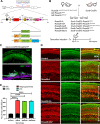

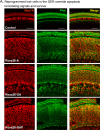

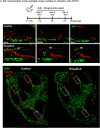
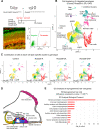
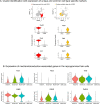









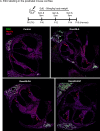
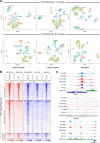

Similar articles
-
Extent of genetic and epigenetic factor reprogramming via a single viral vector construct in deaf adult mice.Hear Res. 2025 Mar;457:109170. doi: 10.1016/j.heares.2024.109170. Epub 2024 Dec 20. Hear Res. 2025. PMID: 39848037
-
Generation of mature and functional hair cells by co-expression of Gfi1, Pou4f3, and Atoh1 in the postnatal mouse cochlea.Cell Rep. 2021 Apr 20;35(3):109016. doi: 10.1016/j.celrep.2021.109016. Cell Rep. 2021. PMID: 33882317
-
Combinatorial Atoh1 and Gfi1 induction enhances hair cell regeneration in the adult cochlea.Sci Rep. 2020 Dec 8;10(1):21397. doi: 10.1038/s41598-020-78167-8. Sci Rep. 2020. PMID: 33293609 Free PMC article.
-
Atoh1 and other related key regulators in the development of auditory sensory epithelium in the mammalian inner ear: function and interplay.Dev Biol. 2019 Feb 15;446(2):133-141. doi: 10.1016/j.ydbio.2018.12.025. Epub 2018 Dec 31. Dev Biol. 2019. PMID: 30605626 Review.
-
Atoh1 in sensory hair cell development: constraints and cofactors.Semin Cell Dev Biol. 2017 May;65:60-68. doi: 10.1016/j.semcdb.2016.10.003. Epub 2016 Oct 14. Semin Cell Dev Biol. 2017. PMID: 27751776 Review.
Cited by
-
Genetic and pharmacologic alterations of claudin9 levels suffice to induce functional and mature inner hair cells.bioRxiv [Preprint]. 2024 Nov 8:2023.10.08.561387. doi: 10.1101/2023.10.08.561387. bioRxiv. 2024. PMID: 37873357 Free PMC article. Preprint.
-
Stem Cell-Based Hair Cell Regeneration and Therapy in the Inner Ear.Neurosci Bull. 2024 Jan;40(1):113-126. doi: 10.1007/s12264-023-01130-w. Epub 2023 Oct 3. Neurosci Bull. 2024. PMID: 37787875 Free PMC article. Review.
-
Sensory cells in tunicates: insights into mechanoreceptor evolution.Front Cell Dev Biol. 2024 Mar 14;12:1359207. doi: 10.3389/fcell.2024.1359207. eCollection 2024. Front Cell Dev Biol. 2024. PMID: 38550380 Free PMC article. Review.
-
Pou4f3 Deficiency Obstructs the Subtype Differentiation of Vestibular Hair Cells.Neurosci Bull. 2025 Aug 24. doi: 10.1007/s12264-025-01474-5. Online ahead of print. Neurosci Bull. 2025. PMID: 40850952
-
Nissl Granules, Axonal Regeneration, and Regenerative Therapeutics: A Comprehensive Review.Cureus. 2023 Oct 28;15(10):e47872. doi: 10.7759/cureus.47872. eCollection 2023 Oct. Cureus. 2023. PMID: 38022048 Free PMC article. Review.
References
-
- Basch ML, Brown RM, Jen HI, Semerci F, Depreux F, Edlund RK, Zhang H, Norton CR, Gridley T, Cole SE, Doetzlhofer A, Maletic-Savatic M, Segil N, Groves AK. Fine-tuning of notch signaling sets the boundary of the organ of corti and establishes sensory cell fates. eLife. 2016a;5:23. doi: 10.7554/eLife.19921. - DOI - PMC - PubMed
Publication types
MeSH terms
Substances
Associated data
- Actions
Grants and funding
LinkOut - more resources
Full Text Sources
Molecular Biology Databases
Research Materials

